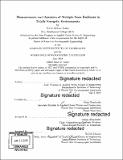Measurements and dynamics of multiple scale bedforms in tidally energetic environments
Author(s)
Jones, Katie Renae
DownloadFull printable version (12.47Mb)
Other Contributors
Woods Hole Oceanographic Institution.
Advisor
Peter Traykovski.
Terms of use
Metadata
Show full item recordAbstract
The presence of superimposed bedforms, where smaller bedforms exist on larger bedforms, is ubiquitous to energetic tidal environments. Due to their wide range in scale, it is difficult to simultaneously observe these features over tidal timescales. This thesis examines the morphological response of superimposed bedforms to a tidally reversing flow using novel instrumentation and platform systems. A method is outlined in chapter 2 to expand the functionality of low-mounted sidescan sonars by utilizing sonar shadows to estimate bedform height and asymmetry. Empirical models are generated to account for realistic variability in the seabed and the method is validated with bathymetric observations of wave-orbital ripples and tidally reversing megaripples. Given the high temporal and spatial resolution of seafloor frame mounted rotary sidescan sonars, the dynamics and evolution of the bedforms over an approximately 40 m x 40 m area can be resolved. In chapter 3 the method is applied to data of superimposed bedforms at Wasque Shoals, an ebb delta off the southeast corner of Martha's Vineyard, MA. These data reveal the small, superimposed bedforms reversing their asymmetry with the flow while the larger bedforms on which they reside remain oriented in the direction of the dominant flow. Similar bedform dynamics are observed at Nauset Inlet, a dynamic inlet system, on Cape Cod, MA using an autonomous jet-powered kayak, the Jetyak, equipped with a bathymetric swath sonar. The time needed for bedform asymmetry to reverse in the presence of a tidal flow was estimated with a geometric bedform model that incorporates an empirical sediment transport rate. The morphological lag time from the observations agree well with the geometric model with larger bedforms and slower flows resulting in a longer lag time. Finally, the migration of these superimposed bedforms is considered in chapter 4. Data from the rotary sidescan sonar at Wasque Shoals capture the interaction of smaller bedforms, or megaripples, with a dune. The net convergence of megaripples on the tidally dominate lee face of the dune suggests that the smaller bedforms serve as an intermediate step between grain-scale transport processes and larger scale dune migration.
Description
Thesis: S.M., Joint Program in Applied Ocean Science and Engineering (Massachusetts Institute of Technology, Department of Mechanical Engineering; and the Woods Hole Oceanographic Institution), 2018. Cataloged from PDF version of thesis. Includes bibliographical references (pages 97-103).
Date issued
2018Department
Joint Program in Applied Ocean Physics and Engineering; Woods Hole Oceanographic Institution; Massachusetts Institute of Technology. Department of Mechanical EngineeringPublisher
Massachusetts Institute of Technology
Keywords
Joint Program in Applied Ocean Science and Engineering., Mechanical Engineering., Woods Hole Oceanographic Institution.